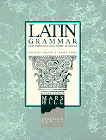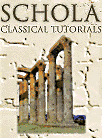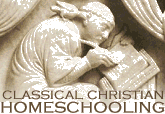Text Only
(Printer-Friendly)
coming soon
Contents
Introduction
Trivium
Grammar
Dialectic
Rhetoric
Homeschool
Curriculum
CCH FAQ
CE Links
Favorite
Reciprocal
What’s New
About CCH
Search CCH
Art History

Classical Christian
Homeschooling:
Classical Education
at Home
WebMaster:
Christine
Miller
CCH’s Online Catalog: Dialectic Stage Language - Grades 7-9
This page last revised:
May 2001
Copyright © 1997-2001
|
Option 1: Henle’s Latin
For 6th-9th grades, or any
beginning Latin student in the 6th grade and up. Henle’s Latin teaches ecclesiastical
pronunciation and includes readings in both classical and Christian authors.
Option 2: Latin Grammars and Wheelock’s Latin
For 7th grade and up. The Latin
Grammars, for 7th-8th grades, prepare a student for the more intensive language study in
Wheelock’s Latin, for 9th grade and up. The Grammars and Wheelock’s teach
classical pronunciation; Wheelock’s includes mostly classical readings; it is a
complete Latin course in one textbook.
Option 3: Homeschool Greek
For 7th grade and up. Designed
for the homeschool, Homeschool Greek is a complete self-study New Testament Greek program.
Option 4: Schola Classical Tutorials in Latin and
Greek
For 9th grade and up. These
excellent Internet tutorials -- Latin I, Latin II, and Homeric Greek -- provide an
experienced Latin and Greek instructor to take students through the classical languages.
 Henle’s
Latin Series Henle’s
Latin Series
Robert Henle
For the 6th-9th grades, or any beginning Latin student in the 6th
grade and up. Henle’s Latin series is a complete ecclesiastical Latin course,
enabling the student to read the classics in Latin upon completion. This program can be
used by dialectic and rhetoric stage beginning Latin students, or grammar stage students
that have completed Latina Christiana I & II. The readings are a rich collection from
both classical and Christian authors. The grammar and syntax is collected in a separate
handbook designed to be used throughout the series. The beginning vocabulary is limited to
help children really master grammar without being overwhelmed by a large vocabulary. The
explanations are thorough, easy to understand, and appealing. First Year Latin
teaches beginning grammar; the Latin Grammar
Handbook is required for use with the First Year text and throughout the series. The Second Year
Latin text is based on Caesar’s De Bello Gallico (The Gallic War). The Third Year Latin
text is based on Cicero’s Orations and Letters. The Fourth Year
Latin text is based on Virgil’s Aeneid.
 Latin Grammar Latin Grammar
Douglas Wilson and Karen Craig
For the 7th grade. Latin Grammar can be used after the completion
of a grammar stage Latin program, such as Latin’s
Not So Tough!, Matin Latin, or the Latin Primers, or for any beginning Latin
student in the 7th grade and up. Latin Grammar teaches classical pronunciation and
introduces the grammar, vocabulary, and translation of Latin sentences deductively. The teacher’s
edition contains the exercises key and tests and keys.
 Latin Grammar II Latin Grammar II
Karen Craig
For the 8th grade, or after the completion of Latin Grammar.
Latin Grammar II builds upon the grammar learned in Latin Grammar, and continues on with
more advanced studies. The teacher’s
edition includes even more teacher aids than in the Latin Grammar teacher’s
edition. The Latin Grammar series is an excellent introduction to Wheelock’s Latin
for dialectic stage students, but they are not prerequisite: any beginning Latin student
in the 9th grade and up may begin with Wheelock’s Latin.
 Wheelock’s
Latin Wheelock’s
Latin
Frederic M. Wheelock
For the 9th grade and up. Wheelock’s is a complete
classical Latin course in one text, and is widely considered the best Latin text
available. This program is intended for beginning Latin students in the dialectic and
rhetoric stages, and is the next text to use after completing the Mars Hill Latin series.
Every lesson contains grammar, learned in sequence; ample vocabulary, lots of translation
practice from the great Roman writers, readings from the great classical works in Latin;
etymology lessons; and other interesting background information on Latin phrases, culture
and history. The accompanying student workbook is not required to understand the course,
but is helpful for additional practice. Wheelock’s includes a self-tutorial
appendix of additional exercises, review, and tests (and key) of every chapter, for those
students working through the text independently. When a student has completed this text,
he is ready to read the classics in Latin. We have taken 3 to 4 years to complete the 40
chapters in Wheelock’s when studying independently.
Study aids for use with Wheelock’s Latin:
Comprehensive
Guide to Wheelock’s Latin by Dale A. Grote. Dr. Grote teaches college Latin
courses using Wheelock’s; and found that increasingly, most undergraduates had a weak
understanding of English grammar which made the explanations in Wheelock’s confusing
for them. Rather than spend all his class time answering English grammar questions and how
it related to the Latin they were studying, he wrote this study guide for his students so
that he could continue to spend class time on Latin. We have found the study guide to be
an invaluable help to us in working our way through Wheelock’s. This guide expands
and explains important grammatical concepts that the Wheelock text presents too briefly
for many contemporary students. It contains full grammatical explanations which aid
student comprehension; useful exercises (with answer key) that quickly clear up confusion;
and additional etymological information which helps students memorize new vocabulary. An
earlier version of the Study Guide is available free on the
Internet, written for an earlier edition of Wheelock’s Latin and with the typos
still intact, but still quite usable and helpful.
Workbook for
Wheelock’s Latin by Paul T. Comeau & Richard A. LaFleur. The Workbook
for Wheelock’s Latin is not necessary to complete the course, but is highly
recommended. It provides much additional vocabulary practice, grammar exercises, and
translation sentences for every chapter of the Wheelock’s text; for every grammatical
concept and new vocabulary introduced. The additional work and practice really helps a
child grasp the paradigms, vocabulary and grammatical structure of the language.
38 Latin Stories
Designed to Accompany Wheelock’s Latin by Anne H. Gorton & James M. May.
In 38 Latin Stories, students can begin reading stories in Latin as soon as they have
completed chapter 3 in Wheelock’s Latin. Stories include passages from Greek and
Roman mythology, Latin translations of The Odyssey and Iliad, Virgil, Cicero’s
Orations, Caesar’s Gallic War, and other classic Roman authors such as Quintilian,
Sallust, Horace, Livy, Pliny, and more.
 Homeschool Greek Homeschool Greek
Harvey Bluedorn
For 7th grade and up. This program is designed to teach New
Testament Greek to beginning dialectic and rhetoric stage students through independent
self-study. It teaches English grammar before it introduces Greek grammar, and includes
vocabulary drill cards, a Greek New Testament Reader (Matthew chapters 5-7, with an
English translation), and audio pronunciation tapes for both the Grammar and the Reader.
Volume I covers mostly nouns, and upon completion the student should have a working
knowledge of Greek nouns, pronouns, adjectives, prepositions, and some knowledge of the
Greek verb system. Volume II covers mostly verbs. Before beginning Homeschool Greek, go
through the Greek
Alphabetarion to learn the Greek alphabet and phonics.
 Schola
Classical Tutorials in Latin & Greek Schola
Classical Tutorials in Latin & Greek
Wes Callihan, tutor
For 9th grade and up. Members of our family have had the
privilege of taking several tutorials with Schola now, and it is a wonderful way to learn
a subject. Wes Callihan knows his material and his highly qualified, and he is a great
teacher--kids love him. The Latin
Tutorials are for beginning Latin students who are at least fourteen years old. The
text used is Wheelock’s. Latin I covers basic grammar and syntax and includes
readings in Latin, and includes cultural and historical study about the Roman and medieval
world. Latin II covers the remainder of the grammar in Wheelock’s Latin and includes
readings in classical and medieval Latin, including the Vulgate Bible. The Homeric Greek Tutorial is for
students who are at least 15 years old, and who have some previous experience with either
Latin or Greek. The course aims to “teach beginners to read Greek intelligently and
with pleasure.” The course covers all essential Greek grammar in a year, including
reading metrically, and by the end of the course the student will have read a large
portion of the first book of the Iliad and will have memorized several dozen lines from
the beginning of the poem.
We used the text, the Study Guide, the Workbook, and 38 Latin Stories. We
set up our own Latin notebook (a 3-ring notebook), in which we would keep our notes and
work in vocabulary, grammar, translations, and tests. The Latin notebook was divided into
Grammar, Verbs, Nouns, Adjectives, Misc. Vocabulary, Text Exercises, Translations, and
Tests sections.
First week: We began each new chapter in Wheelock’s by going through the
Study Guide for that chapter thoroughly, and working through any exercises in the Study
Guide. We entered new paradigms learned in the Grammar section of the notebook. We went
through the new vocabulary list in the text, and entered new vocabulary, declined and
conjugated, in the Verb, Noun, Adjective, and Misc. sections of the notebook. At the
beginning of every day, we drilled new paradigms and new vocabulary.
Second week: We worked through the Workbook for that chapter, completing all the
exercises and practice translations. I assigned the Self-Tutorial Exercises (in the
appendix in the back of the Wheelock’s text) for that chapter as homework. The
Self-Tutorial work was kept in the Text Exercises section of the Latin notebook. This
provided sufficient vocabulary and paradigm practice, usually, to firmly learn each
chapter’s new material.
Third Week: We worked through translating the chapter Practice Sentences,
Sententiae Antiquae, poetry or paragraph adpatation from the classical authors, and the
story corresponding with that chapter from 38 Latin Stories. We kept this work in the
Translations section of the Latin notebook. Use the Wheelock’s Latin Chapter
Translations Key to check the work of both parent and child.
Dale Grote, author of the Comprehensive Study Guide to Wheelock’s Latin, has
posted excellent exams on
his website which test Latin learning for every 5 chapters of Wheelock’s. They are
samples for his students to prepare for the style of the real thing; but they are great to
use as is to test your own children if you feel they need it. We kept tests in the Tests
section of the Latin notebook.
This pace for going through Wheelock’s is slower than at the college level, and
slower than in Schola’s Latin Tutorials. But it has worked well for us (and for me as
the teacher learning Latin along with my kids); using this pace a family can complete
10-12 chapters of Wheelock’s each school year, and finish the entire course in 3 to 4
years. The pace may of course be adjusted, to complete each chapter in less time for
students that have already gone through a grammar stage Latin course and don’t need
as much review or practice, or for rhetoric stage students who can complete more of the
busy work more quickly on their own.
This online catalog is made possible through an association with Amazon.com.
Clicking on the book cover will take you to Amazon’s information page about that
book. You can look at its price, availability, any discounts currently taken for that
title, reviews of the book, and other information, as well as order it if you decide to
purchase the book. You can even place books in your shopping cart and save them for
purchase at a later time. You can continue to add or delete books from your shopping cart
until you are satisfied with your order and ready to purchase. Clicking on your
browser’s “Back” button will bring you back to this catalog.
Sometimes books go out of print, or the publisher runs out of stock. Any
book not available from Amazon.com for any reason can be searched using AddAll.com, a book shopping site which will scan Amazon
as well as Barnes and Noble, Powell’s Books, Book Close Outs and many other new and
used book sites. Be sure to also check BookFinder.com
for out of print book searches.
Still have questions? Ask
me!
 
|


